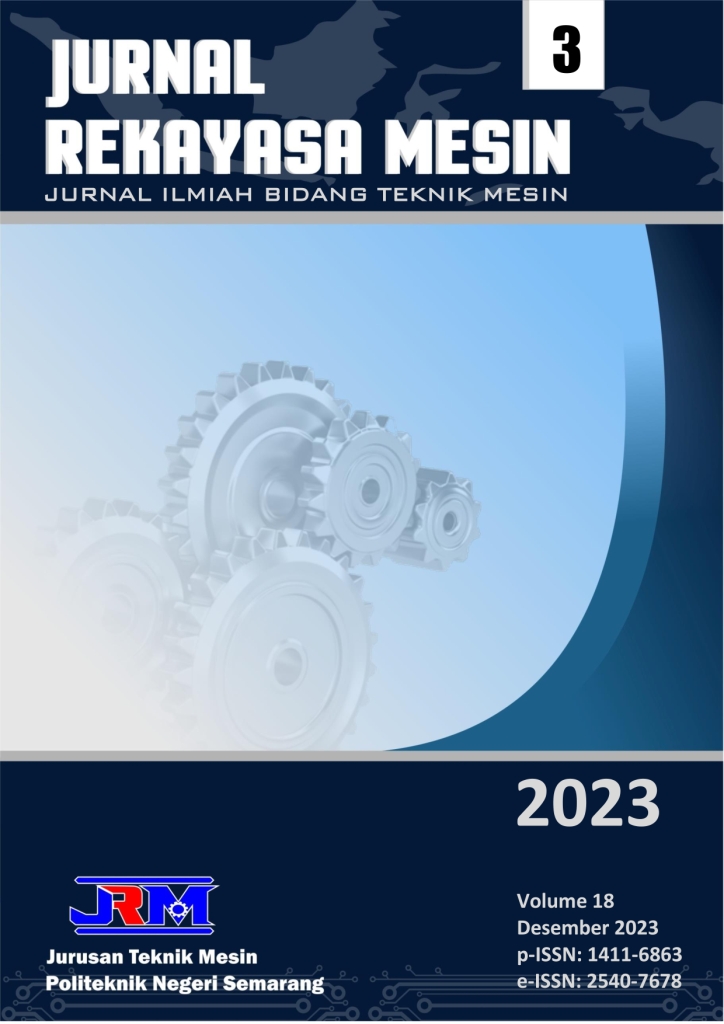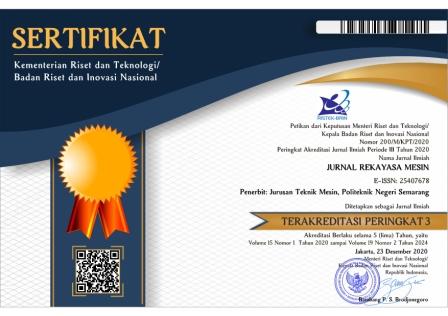Peluang dan Sifat Mekanis Serat Alam Non-Kayu dalam Pembuatan Papan Partikel (Review Paper)
DOI:
https://doi.org/10.32497/jrm.v18i3.5058Keywords:
modulus of elasticity, modulus of rupture, papan partikel, serat alam, serat serabut kelapaAbstract
Penelitian mengenai inovasi produk dalam material komposit merupakan urgensi, salah satu industri yang memiliki potensi inovasi adalah wood-based panels (WBPs) khususnya papan partikel. Selama ini kayu masih menjadi bahan utama dalam produksi papan partikel. Akan tetapi kesadaran konsumen mengenai dampak penggunaan kayu secara berlebih mendorong industri ini untuk mencari alternatif pengganti kayu. Pada penelitian ini dilakukan review yang bertujuan untuk mengetahui, membandingkan, dan mencari peluang serat alam non-kayu sebagai material dalam papan partikel. Berdasarkan 11 jurnal yang telah diulas dari berbagai peneliti di dunia didapatkan hasil bahwa penggunaan serat alam non-kayu adalah feasible jika material tersebut memiliki karakteristik mekanis yang mirip dengan kayu. Serabut kelapa merupakan serat alam yang memiliki potensi menjadi material pengganti kayu pada produk papan partikel. Modulus of elasticity (MOE) dan modulus of rupture (MOR) Spesimen yang telah diuji oleh berbagai peneliti menunjukkan bahwa sifat mekanis serabut kelapa memiliki kemiripan dengan kayu dengan beberapa penyesuaian seperti homogenisasi ukuran partikel dan jenis perekat yang digunakan. Maka dapat disimpulkan bahwa serabut kelapa merupakan salah satu material potensial yang membutuhkan pengembangan lebih lanjut.
References
A. Diaz, T. Reyes, and R. J. Baumgartner, “Implementing circular economy strategies during product development,” Resour. Conserv. Recycl., vol. 184, no. November 2021, p. 106344, 2022, doi: 10.1016/j.resconrec.2022.106344.
F. Ceschin and I. Gaziulusoy, “Evolution of design for sustainability: From product design to design for system innovations and transitions,” Des. Stud., vol. 47, pp. 118”“163, 2016, doi: 10.1016/j.destud.2016.09.002.
J. X. Lim et al., “Development of Particleboard from Green Coconut Waste,” J. Phys. Conf. Ser., vol. 2120, no. 1, 2021, doi: 10.1088/1742-6596/2120/1/012034.
N. Pugazhenthi and P. Anand, “Mechanical and thermal behavior of hybrid composite medium density fiberboard reinforced with phenol formaldehyde,” Heliyon, vol. 7, no. 12, p. e08597, 2021, doi: 10.1016/j.heliyon.2021.e08597.
J. Liang, J. Wu, and J. Xu, “Low-formaldehyde emission composite particleboard manufactured from waste chestnut bur,” J. Wood Sci., vol. 67, no. 1, 2021, doi: 10.1186/s10086-021-01955-x.
X. Mo, E. Cheng, D. Wang, and X. S. Sun, “Physical properties of medium-density wheat straw particleboard using different adhesives,” Ind. Crops Prod., vol. 18, no. 1, pp. 47”“53, 2003, doi: 10.1016/S0926-6690(03)00032-3.
X. Mo, J. Hu, X. S. Sun, and J. A. Ratto, “Compression and tensile strength of low-density straw-protein particleboard,” Ind. Crops Prod., vol. 14, no. 1, pp. 1”“9, 2001, doi: 10.1016/S0926-6690(00)00083-2.
D. Wang and X. S. Sun, “Low density particleboard from wheat straw and corn pith,” Ind. Crops Prod., vol. 15, no. 1, pp. 43”“50, 2002, doi: 10.1016/S0926-6690(01)00094-2.
D. Maldas and B. V. Kokta, “Studies on the preparation and properties of particle boards made from bagasse and PVC: II. Influence of the addition of coupling agents,” Bioresour. Technol., vol. 35, no. 3, pp. 251”“261, 1991, doi: 10.1016/0960-8524(91)90122-Z.
G. A. Ntalos and A. H. Grigoriou, “Characterization and utilisation of vine prunings as a wood substitute for particleboard production,” Ind. Crops Prod., vol. 16, no. 1, pp. 59”“68, 2002, doi: 10.1016/S0926-6690(02)00008-0.
R. Rocha Almeida, C. Henrique Soares Del Menezzi, and D. Eterno Teixeira, “Utilization of the coconut shell of babaçu (Orbignya sp.) to produce cement-bonded particleboard,” Bioresour. Technol., vol. 85, no. 2, pp. 159”“163, 2002, doi: 10.1016/S0960-8524(02)00082-2.
A. R. Pai and R. N. Jagtap, “Surface morphology & mechanical properties of some unique natural fiber reinforced polymer composites-a review,” J. Mater. Environ. Sci., vol. 6, no. 4, pp. 902”“917, 2015.
M. Lewin, Handbook of Fiber Chemistry, 3rd Editio. Boca Raton: CRC Press, 2006.
G. B. Paul, M. C. Timar, O. Zeleniuc, A. Lunguleasa, and C. CoÈ™ereanu, “Mechanical properties and formaldehyde release of particleboard made with lignin-based adhesives,” Appl. Sci., vol. 11, no. 18, 2021, doi: 10.3390/app11188720.
N. A. Karim, N. A. F. N. Lah, S. A. Rahman, W. N. A. W. Nadhari, and Z. F. Z. Gaffar, “Strength properties of mixed cocopeat fibres and Merawan Siput Jantan (Hopea odorata spp.) bonded with partial rubber latex adhesive and nano- SiO2 in particleboard manufacturing,” in AIP Conference Proceedings 2454, 2022, p. 080008, doi: https://doi.org/10.1063/5.0078301.
C. R. P. Narciso, A. H. S. Reis, J. F. Mendes, N. D. Nogueira, and R. F. Mendes, “Potential for the Use of Coconut Husk in the Production of Medium Density Particleboard,” Waste and Biomass Valorization, vol. 12, no. 3, pp. 1647”“1658, 2021, doi: 10.1007/s12649-020-01099-x.
Ismadi et al., “Investigation of optimum particles size and citric acid content for coconut husk particleboard manufacturing,” AIP Conf. Proc., vol. 2454, no. June, 2022, doi: 10.1063/5.0078508.
P. W. Olupot, E. Menya, F. Lubwama, L. Ssekaluvu, B. Nabuuma, and J. Wakatuntu, “Effects of sawdust and adhesive type on the properties of rice husk particleboards,” Results Eng., vol. 16, no. November, p. 100775, 2022, doi: 10.1016/j.rineng.2022.100775.
R. G. D. A. Mesquita et al., “Coir and sisal fibers as fillers in the production of eucalyptus medium density particleboards - MDP,” Mater. Res., vol. 19, no. 6, pp. 1429”“1436, 2016, doi: 10.1590/1980-5373-MR-2016-0361.
P. Kongkaew, W. Sila, S. Saiying, and W. Pharanat, “Mechanical and physical properties of particleboard made from scirpus grossus and coconut fiber,” J. Phys. Conf. Ser., vol. 1380, no. 1, 2019, doi: 10.1088/1742-6596/1380/1/012068.
M. R. Lubis, T. Maimun, J. Kardi, and R. B. Masra, “Characterizing Particle Board Made of Oil Palm Empty Fruit Bunch Using Central Composite Design,” Makara J. Sci., vol. 22, no. 1, 2018, doi: 10.7454/mss.v22i1.6988.
P. Antov, V. Savov, L. KriÅ¡t”™Ã¡k, R. Réh, and G. I. Mantanis, “Eco-friendly, high-density fiberboards bonded with urea-formaldehyde and ammonium lignosulfonate,” Polymers (Basel)., vol. 13, no. 2, pp. 1”“13, 2021, doi: 10.3390/polym13020220.
T. D. Sutanto, C. Banon, B. Trihadi, and N. F. Damayani, “Effect of Grain Size Coconut Frond Powder on the Strength of Particle Board,” J. Phys. Conf. Ser., vol. 1940, no. 1, 2021, doi: 10.1088/1742-6596/1940/1/012043.
S. M. Sapuan, M. Harimi, and M. A. Maleque, “Mechanical properties of epoxy/coconut shell filler particle composites,” Arab. J. Sci. Eng., vol. 28, no. 2 B, pp. 171”“181, 2003.
D. C. R. Velasco, F. Perissé Duarte Lopes, D. Souza, H. A. Colorado Lopera, S. Neves Monteiro, and C. M. Fontes Vieira, “Evaluation of Composites Reinforced by Processed and Unprocessed Coconut Husk Powder,” Polymers (Basel)., vol. 15, no. 5, p. 1195, Feb. 2023, doi: 10.3390/polym15051195.
Downloads
Published
How to Cite
Issue
Section
License
Copyright of articles that appear in Jurnal Rekayasa Mesin belongs exclusively to Penerbit Jurusan Teknik Mesin Politeknik Negeri Semarang. This copyright covers the rights to reproduce the article, including reprints, electronic reproductions, or any other reproductions of similar nature.







